

TRANSPORT SYSTEMS IN THE ISLE OF WIGHT
2.0 VEHICLE AND PASSENGER FERRY SERVICES
2.1 Introduction
There are seven regular services to the Island provided by three main carriers - Wightlink, Red Funnel and Hovertravel. All the passenger boat services have their roots in the steam packets of the 19th Century, and the early development of tourist traffic to the Island. The involvement of the railway companies provided links to London and the rest of the country. The railways took over the services from Lymington and Portsmouth in the 19th Century, and they were in the ownership of British Rail until the sale of the whole Sealink group. The majority of the former Sealink are now part of the Stena group, but the Isle of Wight ferries, under the brand name Wightlink, are in the ownership of the Sea Containers group.
The Red Funnel group are owned by the Southampton, Isle of Wight and South of England Royal Mail Steam Packet Limited Company, the longest company name registered. Again with roots in the 19th century, this company will have been operating ferry services in the area for 135 years in 1996. The company has now consolidated its services to those between Southampton and Cowes, which both complement and compete with those operated by Wightlink.
2.2 Ferry Timings
|
Mainland |
Island |
Type |
Vehicle |
Foot |
Bikes |
Time |
Operator |
|
Portsmouth |
Fishbourne |
Car Ferry |
Yes |
Yes |
Yes |
40 min |
Wightlink |
|
Portsmouth |
Ryde |
Catamaran |
|
Yes |
Yes |
15 min |
Wightlink |
|
Southampton |
Cowes (East) |
Car Ferry |
Yes |
Yes |
Yes |
60 min |
Red Funnel |
|
Southampton |
Cowes (West) |
Catamaran |
|
Yes |
|
20 min |
Red Funnel |
|
Southampton |
Cowes (West) |
Hydrofoil |
|
Yes |
|
20 min |
Red Funnel |
|
Southsea |
Ryde |
Hovercraft |
|
Yes |
|
8 min |
Hovertravel |
|
Lymington |
Yarmouth |
Car Ferry |
Yes |
Yes |
Yes |
30 min |
Wightlink |
For some passengers, the length of journey and speed of travel is important, for whom the catamaran, hydrofoil and hovercraft are provided. Passengers with more time can travel on one of the car ferry services. Travelling with a vehicle requires more planning, particularly if a popular journey time is desired. For the un-booked car traveller, a long wait for a vacant space might be the order of the day, unless less popular times are chosen - the Fishbourne service operates throughout the night! Skill of loading staff on the ships means that at peak times and in the event of a cancelled sailing, the vehicles are loaded so tightly that the maximum number of vehicles are transported. The services operate in all weathers, although in heavy seas and fog the journey times may be extended.
All services are reduced in frequency during the winter period, to correspond to the requirements. This gives the operators the opportunity to maintain the ships since, for the full peak summer service, the ships are all fully utilised, and none of the operators have spare ships available to cover if a ship is not available, although in my experience, it is rare for a ship to be taken out of use for a defect. All the car ferries are fitted with the Voith Schneider Car Ferry Propulsion system, which utilises vertical and variable pitch propeller assemblies to effectively enable the ship to move in any direction or to hold stationary. This clever system means that ships can manoeuvre in tight confines and quickly berth at the linkspans of terminals. The double ended nature of the ships makes loading and unloading of vehicles very quick and easy.
Various operators have attempted to enter the market over a number of years with experimental services over different routes or using novel technology, such as hovercraft or surface effect craft of various types. However, all of these services with the notable exception of the Hovertravel service between Ryde and Southsea, have ceased after a short period. The long established traditional routes have advantages that the newcomers can not overcome to make their services viable. However, the traditional operators have all taken advantage of the new technology to improve their services, and to strengthen their commercial position. Perhaps the clearest example of this is the replacement of three traditional ferries on the Ryde to Portsmouth route, with two catamarans. The passenger had the journey time reduced from 40 minutes to 15 minutes, at an increased and regular frequency, whilst the operator reduced the costs by reduction in staffing and the number of vessels required for the service.
2.3 Passenger Ferry Services
2.3.1 Ryde - Portsmouth Catamaran
This service is operated by two catamarans built in Tasmania and introduced in 1986. Our Lady Pamela (1986) and Our Lady Patricia (1986) are named after the daughters of the late Lord Mountbatten, the former Governor of the Isle of Wight. The service operates between the railway stations at Portsmouth Harbour and Ryde Pierhead. The service is generally half-hourly and connects into the rail service to Shanklin on the Island and the trains to London and the South Coast at Portsmouth. It is operated by Wightlink, a subsidiary of the Sea Containers group. The Ryde terminal has the disadvantage that it is at the end of a half mile long pier, requiring the use of a train to reach the town at Ryde, which increases the 15 minute sea journey by about another ten minutes.
Whilst Our Lady Patricia (1986) was delivered as deck cargo on a large motor vessel, the Our Lady Pamela (1986) was delivered under her own power from Tasmania, a journey of over fourteen thousand miles, halfway around the world. There can thus be little doubt as to her ability to travel the three and a half miles across the Solent.
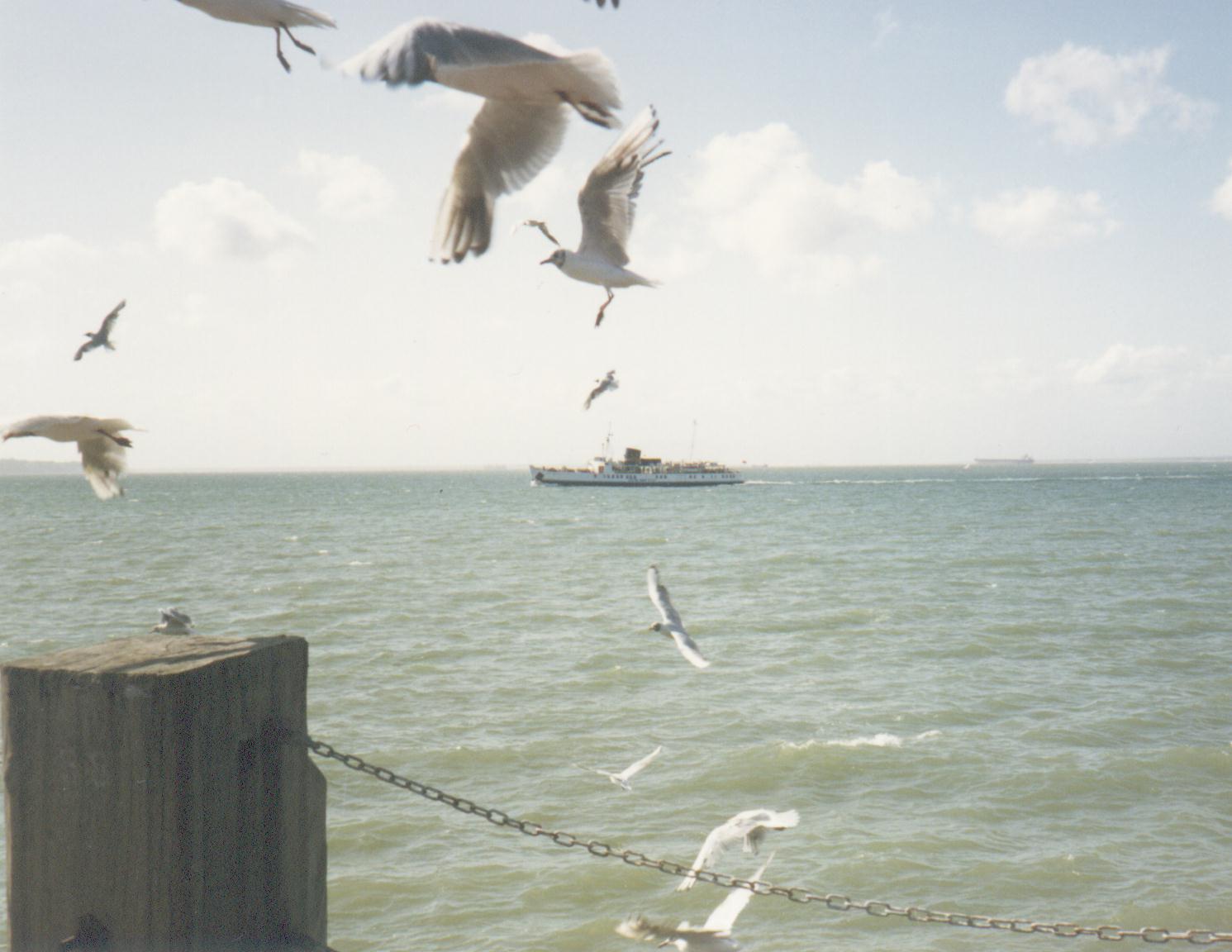
The former Portsmouth -Ryde ferry "Southsea"
2.3.2 Ryde - Southsea Hovercraft
By far the fastest passenger crossing is that between Ryde Esplanade and Southsea in Hovertravel's type AP1-88/100 Hovercraft, the only commercially successful route of a number initiated by British Rail's Seaspeed in the 1960's. This is an airline style service operating generally half hourly, but increased to 15 minute intervals at peak times. The terminals are both well sited offering car parking, bus and train services on the Island, and car parking with easy access to Southsea and Portsmouth town centre on the mainland. There is a bus to the rail station, operated to meet the hovercraft. This service could give 20 minutes advantage over other services. The craft in use in spring 1996 were Double - 0 - Seven and Freedom 90. This company promotes travel from the Island to the mainland by discounting the fares from Ryde.
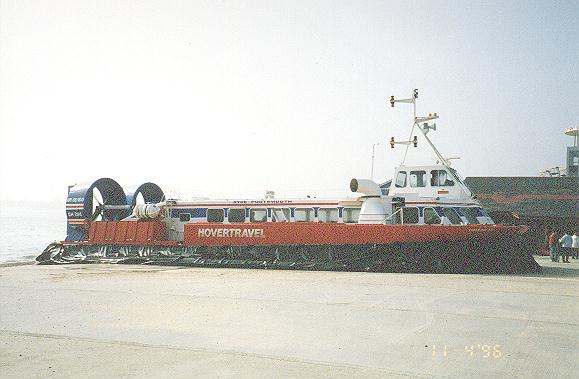
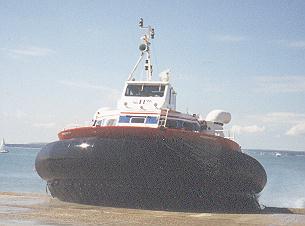
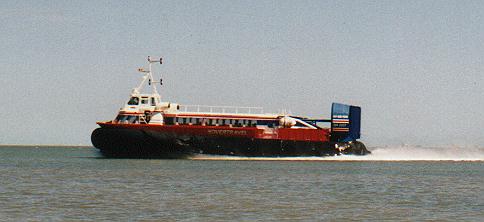
2.3.3 Cowes (West) - Southampton Catamaran / Hydrofoil
Red Funnel operate this high speed service in parallel with the car ferries on the Southampton route. Using small Red Jet class catamarans and Sheerwater class hydrofoils.
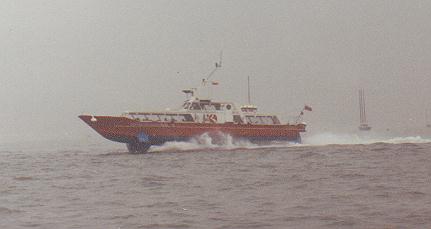
Sheerwater class Hydrofoil
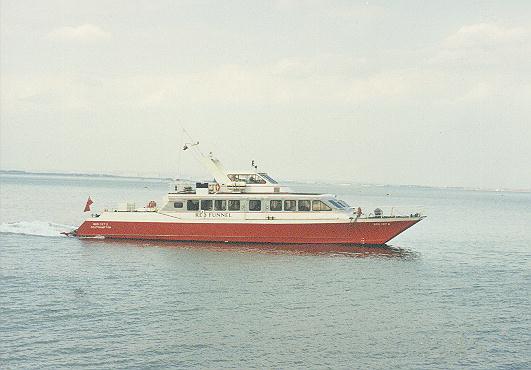
Red Jet 2
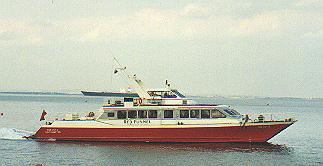
Red Jet 4
2.3.4 Cruises
Blue Funnel, Solent Cruises (Jenny Boats) and Wight Lines amongst others, operate a number of regular local ferry journeys to Calshot and Hamble, day trips and cruises from the Island both for visitors and local people from the piers at Ryde, Cowes, Sandown and Yarmouth. Tourist trips are sightseeing cruises, but often involve a stop on the mainland which offers the opportunity for local people to visit the shops, often at a lower fare than the regular ferries. These craft also provide a medical emergency service to the mainland and have sometimes deputised for the main ferries and the floating bridge during failures and refits.